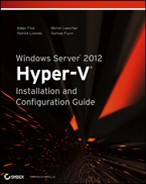Introduction
Windows Server 2012 Hyper-V brings something new to the market. Microsoft marketing materials claim that this release goes “beyond virtualization.” That might seem like hyperbole at first, but take some time to look at how you can change the way IT works by building a private, public, or hybrid cloud with Hyper-V as the engine of the compute cluster. Then you’ll understand how much work Microsoft put into this release.
The original release of Hyper-V was the butt of many jokes in the IT industry. The second release, Windows Server 2008 R2, brought respectability to Hyper-V, and combined with the System Center suite, was a unique offering. It was clear that Microsoft was focusing on service, not servers, recognizing what businesses value, and empowering IT staff to focus on engineering rather than on monotonous mouse-click engineering. Then came the Windows Server 2012 announcements at the Build conference in Anaheim, California, in 2011. Even Microsoft’s rivals were staggered by the scale of the improvements, choosing to believe that the final release would include just a fraction of them.
We now know that Microsoft took an entire year after the release of Windows Server 2008 R2 to talk to customers, gather requirements and desires, and plan the new release. They listened; pain points such as the lack of supported NIC teaming were added, difficulties with backup in Hyper-V clusters were fixed, and little niggles that caused administration annoyance had their corners rounded. More important, Microsoft had a vision: Windows Server 2012 would be “built from the cloud up” (another line from Microsoft’s marketing). This is the first hypervisor designed to be used in a cloud rather than trying to build wrappers around something that focuses on servers first. Many features were added and improved to enable a business to deploy a private cloud, or a service provider to build a flexible, secure, and measured multi-tenant public cloud. Much of this release is ready to go now, but Microsoft built for the future too, with support for emerging technologies and scalability that is not yet achievable in the real world.
Usually with a Microsoft release, you’ll hear headlines that make you think that the product is designed just for massive enterprises with hundreds of thousands of employees. Windows Server 2012 Hyper-V includes features that honestly are intended for the upper end of the market, but some of the headline features, such as SMB3.0 storage or Hyper-V Replica, were designed to deal with the complexities that small/medium enterprises have to deal with too.
This book is intended to be your reference for all things Windows Server 2012 Hyper-V. The book was written by three MVPs and a Microsoft consultant who give you their insight on this product. Every chapter aims to give you as much information as possible. Starting from the basics, each chapter will bring you through concepts, showing you how to use and configure features, and lead you to the most complex designs. Most chapters include scenarios that show you how to use Windows Server 2012 Hyper-V in production, in customer sites or your own.
PowerShell was added in Windows Server 2012, and you’ll find lots of PowerShell examples in this book. This was a deliberate strategy. Most IT pros who have not used PowerShell are scared of this administration and scripting language, because it is different from how they normally work. Pardon the pun, but it is powerful, enabling simple tasks to be completed more quickly, and enabling complex tasks (such as building a cluster) to be done with a mouse click. You don’t need to be a programmer to get to a point where you use PowerShell. None of this book’s authors are programmers, and we use the language to make our jobs easier. If you read this book, you will find yourself wanting to use and understand the examples, and hopefully you’ll start writing and sharing some scripts of your own.
The book starts with the basics, such as explaining why virtualization exists. It then moves through the foundations of Hyper-V that are common to small or large enterprises; gets into the fun, deep, technical complexities; and returns to common solutions once again, such as disaster recovery, backup, and virtual desktop infrastructure.
